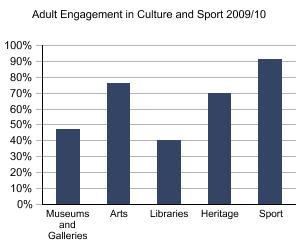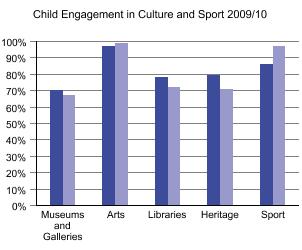This topic covers engagement in culture and sport by adults and children in England. Engagement is defined as going to a historic environment site, a museum or gallery, a library, or an arts event. It also means to take part in an arts activity or active sport.
Publications
Report showing the total amount of charitable giving received by DCMS-funded cultural institutions, and also presents this charitable giving as a ratio of grant-in-aid.

The Bulletin provides summary information as well as some trend data from previous years. It includes information on - smoking, household composition, debt, internet access, health, sport and leisure, environmental issues, mobile phones and job applications.
Impact of economic downturn on cultural and leisure activities and events

This statistical release presents the figures related to entertainment licensing in England and Wales, detailing the number and type of entertainment licences by local authority.
Survey findings on public library usage
Frequency of visits to museums, how much respondents enjoyed last visit and overall satisfaction with museums provision in Northern Ireland
Continuous Household Survey 2008/09 - Arts
This statistical release presents the figures related to the export of objects of cultural interest, which will be included in the report on the operation of the control of such objects which the Secretary of State is required to present to Parliament under Section 10 (1)(a) of the Export Control Act 2002 (the ‘Act’).

The data tables on Internet Access show information about households with home access to the Internet and individuals' use of the Internet.
Quarterly estimates of people who have ever or never used the Internet
Performance data from seventeen of our sponsored museums and galleries.
Monthly figures on museum and gallery visits.
Survey findings on sports participation in Northern Ireland

Information on participation in cultural activities, attendance at cultural events, volunteering, use of the internet and factors that influence participation.

Information on participation in sporting activities, attendance at sporting events and factors that influence participation.
This statistical release presents the number of finds of treasure and portable antiquities reported and recorded through the Portable Antiquities Scheme.
Providing views on Ulster-Scots culture, heritage and language in Northern Ireland
Annual figures on cost per pupil of school games

Survey on the extent and nature of engagement and non-engagement in culture, leisure and sport among adults aged 16 years and above.
Contain analysis from the Continuous Household Survey including participation, frequency and satisfaction
Secondary analysis of NI Young Persons Behaviour and Attitudes Survey 2007
Overview
Data on culture and sport mainly focuses on participation/attendance in these areas, along with either the reasons for doing so/not doing so. This information helps us to improve he opportunities available and the quality of the experience.
The main source of data on culture and sport in England is the Taking Part survey. This provides annual data on participation and attendance, as well as quarterly data on a range of topics. The core questions in the survey ask about:
- Arts participation/event attendance in the last 12 months.
- Museum/gallery visits in the last 12 months
- Historic environment (heritage) site visits in the last 12 months
- Public library service usage in the last 12 months
-
Sport/physical activity in the last 4 weeks
In addition to this, there are other questions on areas such as digital engagement and volunteering and charitable giving in culture and sport. The survey will interview approximately 14,000 adults (16 and over) in 2010/11, and 2,500 children aged 5-15. Children aged 5-10 are only asked (via a parent) about activities outside of school, whilst children aged 11-15 are asked about activities both in and outside school.
Technical Data
This section provides an overview of the key features of the Taking Part survey methodology. More detailed information is provided in the survey’s technical report, available on the DCMS website and from the UK Data Archive.
Adult survey
Sampling
The Taking Part survey covers a representative sample of adults aged 16 and over living in England. The sample was selected from the small-users Postcode Address File, and is restricted to private households only. This means businesses and other non-private accommodation, such as student halls of residence and care homes, are not included.
The sample consists of approximately 14,000 core interviews every year. The sample is classified by region, population density and by the proportion of residents classed as managerial, professional, or as full-time students.
Fieldwork
The interviews are issued between April one year and March the next. The interviews are conducted continuously over this period.
At the beginning of the survey year, the full sample is drawn and divided into 12 groups, representing each month of the survey. If the interview is not achieved on the first attempt, the household is approached on a number of occasions. This accounts for the time delay between the end of the survey year and the completion of the interviews.
Interview
Prior to the interviewer calling at the address, the selected household is sent a letter and a leaflet providing information about the survey.
If the address contains more than one eligible household or the household contains more than one eligible respondent, the interviewer will make a random selection. Once selected, no substitutions are allowed.
The interview is conducted by Computer Assisted Personal Interviewing. This is where the questionnaire has been turned into a computer programme. The programme specifies the questions, the range and structure of acceptable answers, and gives instructions for navigating through the questionnaire. This method enables plausibility and consistency checks to be incorporated into the questionnaire and allows the interviewer to enter the answers straight onto a laptop, both of which help improve data quality.
Survey respondents are asked about their engagement and non-engagement in activities during the 12 months prior to the day of interview. There is no geographical restriction placed on where the activity took place.
The survey measures involvement in activities where the purpose is for recreation or leisure, including voluntary work. It does not include involvement in activities where the prime motivation is paid work or academic study. The exceptions to this are attendance to historic environment sites, which includes visits made for academic study, and participation in sport. However, it does not include refereeing, officiating and coaching.
The length of the interview varies according to answers given by respondent but the average length is 40 minutes.
Child survey
If the selected adult is also the parent or guardian of a child aged 5-10, we ask the parent to answer questions about this child’s activities via a proxy interview. These proxy interviews for 5-10 year olds were added in the 2008/09 survey. In those households containing at least one child aged 11 to 15; an interview is also sought with a randomly selected child in this age group. This was included from 2006 onwards.
In total, 2,500 child interviews are conducted annually. If there are two (or more) children aged 5-10 or 11-15, one of them is randomly selected for interview. If there is only one, then that child is interviewed.
Similar to adult respondents, children are asked about their engagement and non-engagement in activities during the 12 months prior to the day of interview. Children aged 5-10 are only asked about activities outside of school, whilst children aged 11-15 are asked about activities both in and outside of school. There is no geographical restriction placed on where the activity took place.
Glossary
-
Archives
Places that keep archives are usually called a record office or archive centre. Archives are documents that have been created by families, individuals, businesses or organisations and have been specially chosen to keep permanently. They can be written papers such as letters or diaries, maps, photographs or film or sound recordings. Archives are historical documents but do not have to be very old.
-
Arts attendance events
Exhibition of art, photography or sculpture. Craft exhibition, Video or electronic artevent, Event connected with books or writing, Street arts, Carnival, Culturally specificfestival, Play or drama, Theatre performance (excluding plays or drama), Opera oroperetta, Classical music performance, Jazz performance, Live music event (excluding jazz or classical), Ballet, Contemporary dance, African people's dance orSouth Asian and Chinese dance, Other live dance event.
-
Arts participation activities
Ballet, Dance (not for fitness) (excluding Ballet), Singing to an audience, Playing a musical instrument to an audience or for pleasure, Writing music, Rehearsing/performing in a play or drama, Rehearsing/performing in an opera, Painting, drawing, printmaking or sculpture, photography as an artistic activity, Making films or videos as an artistic activity, Creating original artworks using a computer, Textile crafts, Wood crafts, Crafts (excluding textile and wood crafts), Bought any original works of art for yourself, Bought any original/handmade crafts such as pottery/jewellery, Writing stories/plays, Writing poetry.
-
Historic environment sites
A city/town with historic character, A historic building open to the public (non religious), A historic park/garden/landscape open to the public, A place connected with industrial history or historic transport system, A historic place of worship attended as a visitor, A monument such as a castle/fort/ruin, A site of archaeological interest, A site connected with sports heritage (such as Wimbledon) (not visited to watch sport).
-
Sport activities
Swimming/diving, Cycling, BMX, cyclo-cross, mountain biking, Bowls, Tenpinbowling, Health, fitness, gym or conditioning activities, Keepfit, aerobics, dance exercise, Martial arts, Weight training, Weightlifting, Snooker/pool/billiards, Darts, Rugby Union, Football, Cricket, Archery, Netball, Tennis, Badminton, Squash, Basketball, Table tennis, Jogging/cross-country/road running, Angling/fishing, Ice skating, Golf/pitch and putt/putting, Skiing, Horse riding, Climbing/mountaineering, Hill trekking/backpacking, Motor sports, Shooting, Volleyball, Rounders, Boxing, Yoga, Water sports, Other sport. Utility cycling and all forms of walking are excluded.
Contact Details
For statistical enquiries about this topic, please contact:
Evidence and Analysis Unit
Email: takingpart@culture.gsi.gov.uk
Telephone: +44 (0) 20 7211 6200
Department for Culture, Media and Sport 2-4 Cockspur Street London SW1Y 5DH


